#relikviář
Explore tagged Tumblr posts
Text


já tak chápu výběr objektů v tomhle Švankmajerově relikviáři, šitíčko ve mně taky vzbuzuje erotické i thanatické pocity
36 notes
·
View notes
Text
Two Christian relics in Czechia
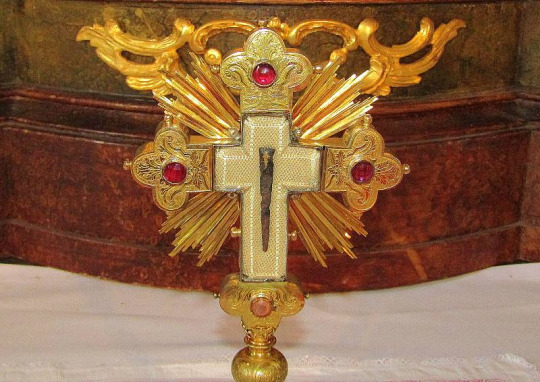
I am from Czechia, country known historically as Duchy, later Kingdom of Bohemia. We have complicated relationship with religion. We have the highest number of atheists in the world. There is long and complicated history, involving catholics and protestants, lots of politics and bloodshed. If you didn’t hear of Hussites, 30 year war, check it out, to get some of the basics.
I was never raised up to religion. I don’t know that much about any faith, tbh.
But Czechs as culture, we have surpring level of respect towards the churches and monastical buildings and history overall. Doesn’t mean we believe, but we respect the history of any historical place or historical item and effort put into building/making it.
So I’d like to introduce you a bit to history of my country, and I’d like to start with items perhaps not so interesting to us czech nowadays, but perhaps to other nationalities more so. Some of the religious relics of Bohemia/Czechia.
So read further if you’re interested.
For now, I’ll skip the remains of various saints, as the dressed up corpses creep me out more than Sedlec Ossuary:
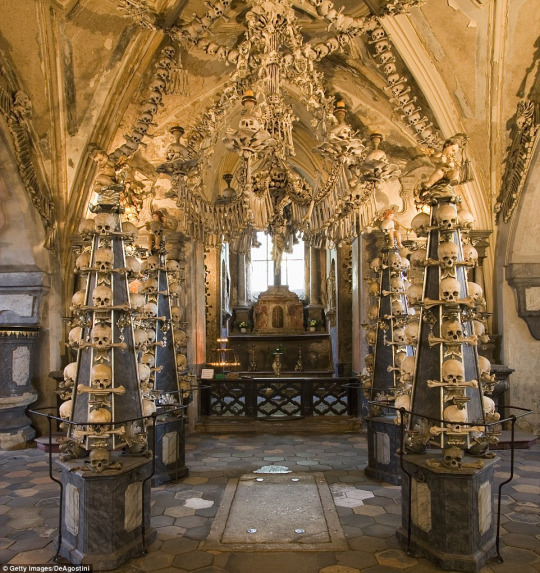
It was inspiration for decor certain horror-tv show, but actually it is place where some soil from Holy Land was brought to and people wanted to be burried there. Yet over time there was not enough space and they started to do this. There is way more bones than you see in this picture! Few years back, they had to take all the remains out to do restoration work to building itself and then carefully return them all back. It’s intersting place, but somehow naked bones don’t scare me as much as when you put clothes upon them. So no saints today.
It might come as surprise, but the most known religious relic in Czechia-the The Reliquary of St. Maurus, is not here from romanesque times, but only from the end of 19th century. It wasn’t public knowledge it was in the country back then. One noble family kept it on their property, in private, right until it was hidden by them after WW2 ended. Nobody but them knew of it. The reliquary of St. Maurus(bellow):
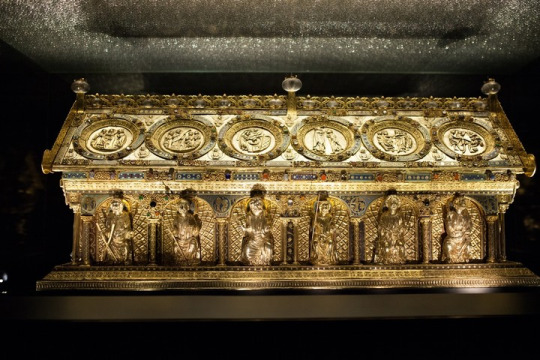
It is beautiful and located in castle of Bečov nad Teplou, in western part of country(not that far from Germany). It considered to be the second most important historical artifact in the Czechia after the Czech Crown Jewels. But it is not relic which christian public would come to visit historically. As I said, it was hidden.
But strangely, it is not the only relic that nobody knew about. And even for much longer time. The relic discovered in hidden vault in 2020, exceeds it in importance. How you ask?
Not in beauty, but certainly in carbon dating. You probably never heard of Milevský relikviář(The Reliquary of Milevsko). Hell, I lived here all my life, and I still didn’t notice it in news in 2020. At the time it didn’t really make the main news. It wasn’t spoken about. But I think it is pretty amazing find.
Milevsko is a town, in Czechia, where in 12th century a premostraterian monastery was built. Once, it was one of the richest in the country. But in 1420 it was burned down by Husits. As many other religious places I’ve been to on various trips, it was robbed and burned down by them. (So if somebody tells you they were all about religious reforms and they were all nice, just as with Disolution of Monasteries during Henry VIII’s reign, a lot of it was to do with people searching for excuse to rob and destroy a rich monastic place.)
Long story short, the monastery once again belongs to the monks, and archeological works were carried out bit by bit, as monastery gets repaired. And boy, did they find a treasure!
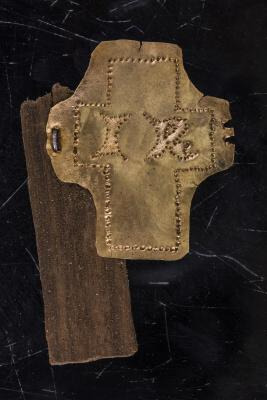
You must have heard of INRI, well IR is shorter version of it-Iesus Rex, Jesus the King. This litle piece of metal,is from pure gold, even though most relics or their casings are merely gilded. It was found in vault, in particularly well-hidden spot, where it probably stayed since before the monastery burned down in 1420. For 600 years, certainly since 1500 at least. The Husits and 30 year old war, has eradicated all the records of what it might have been.
But the very fact the monastery was among richest in the Kingdom, suggests lots of pilgrims came there. Yet by the time this was found, nobody knew of possible of Holy Relic being here. And when they found it, aside from the location, and the gold, it didn’t look as much. Pile of rotted wood, with bit of gold and IR letters.
But based upon those letters archeologists started to suspect that it could relic related to christ, namely part of the Holy cross. But they were wrong.
Among the rotten wood and gold once forming the box was cca 6 cm of metal, adorned with golden cross(mark sometimes put on religious relics, labelled them as the relic).
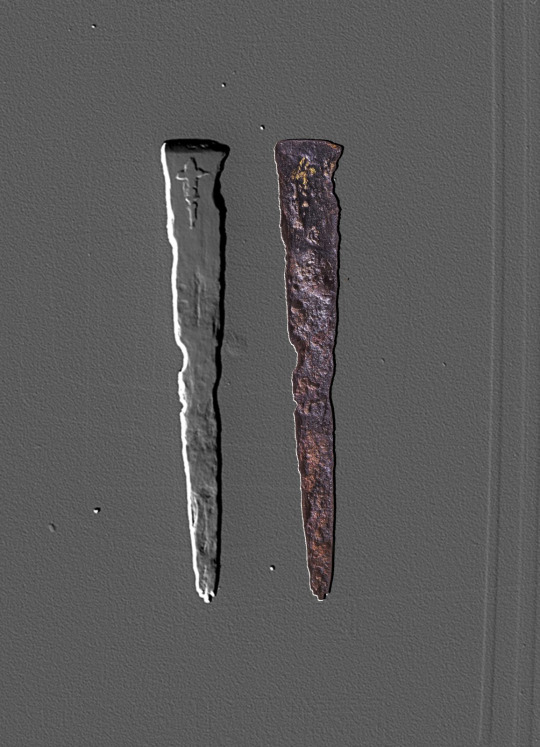
It was part of the iron nail. But just as splinters of holy cross are truly many(and their autenticity uncertain), there are many alleged true Holy nails.
And here is where this gets truly interesting. They carbon dated the wood. There were two types:
Lighter wood-larch, 1290 – 1394, hence possibly from during reign of Emperor Charles IV(also King of Bohemia), man who was very religiously involved and liked to collect and care for relics.
And darker oak wood, which was from middle east(probably from Byzantine Empire). Carbon dated to 260 to 416 AD.
This nail has at least 1600 year old history. Making it very exciting find.
Because currently, it is the only Holy Nail(or its part) which we can prove had been worshiped since at least 5th century.
And it makes likelihood that it genuine, that much greater.
Experts also found reason why the reliquary outer box was not made of something more sumptuous(there was bits of silver and gold, but no rare stones). We’d expect something more like Reliquary of St. Maurus. Instead we have pile of rotten wood.
But experts found that wood was painted with the most expensive pigment of the time-the natural ultramarine(from lapis lazuli). So it was held in VERY sumptuous box- like blue sky. But of course over time, in its hiding place it was not taken care of and eventually it rotted away.
Also, according to wikipedia, there are 3 other Holy nails which are just part of the nail, I certainly hope, that somebody will try to see if any of those other parts might have once fitted together. (Which sadly might be impossible due to erosion of the metal, but who knows?)
If anybody was interested, in future the alleged Holy Nail will be in Milevsko Monastery. They are preparing pernament exhibition of it, but it is not ready yet. The nail itself needs proper security and microclimate. So it will probably be shown to public only on special occasions, before then.
Is it worth it to go and see it? Only few days ago, I’d say not for the estetics of it!
But on 13th of September 2022 the monastery has officially introduced the relic to the public and it transpired they had the nail set in very respectul way:
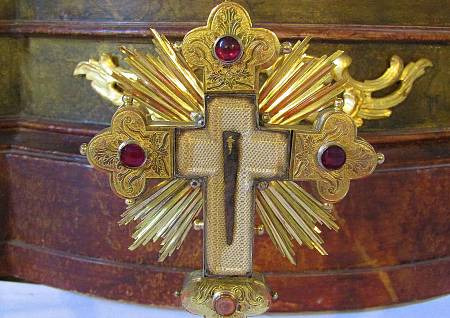
And it looks like a proper relic once more. The cross it is set in, is not very large. But neither is the nail, so I think it is actually perfect size, so that you could look at it and focus on that nail, and not the suroundings.
There are two more things I also find interesting about this relic.
Vatican has previously said that authenticity of various alleged Holy Nails cannot be verified-including one in Prague, which is alegedly part of Treasury of St. Vitus Cathedral-namely the Coronation Cross:
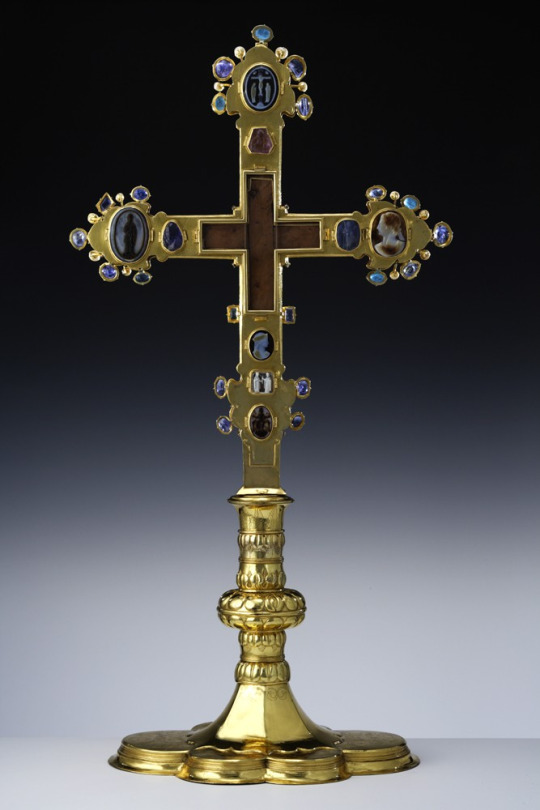
It has not been verified that nail is actually there(or at least part of it), but who had the cross made? -Emperor Charles IV.
This is especially interesting conection, because the archeologists only started to probe the hole within the vault in the Milevsko monastery, after having discussion with somebody else about the vault in St. Vitus Cathedral(which was build during Emperor Charles IV’s reign). Without doing so, they’d not find the relic.
The vaults are of very similiar design. Coincidence? Maybe. But perhaps the Emperor had funded both the vault in St. Vitus and in the monastery and gifted them this relic.
The other interesting thing is that monastery has decided to have logo made for the relic.It’s very simple, but on point. It truly hit the nail on head.(Sorry I couldn’t resist saying that.)

In past they used coat of arms and flags, these days its logos. You know, the relic is not yet very known by christians around the world and monastery is hoping to atract the pilgrims or just curious tourist. So they have to somehow start to present this relic to the public and this is one of the ways to go.
Also its discovery also gives hope of finding in the future some other lost relics.
I’ll be honest, I am trying to promote a bit my own country.
But the story seems also amazing to me. To even get to the vault was not easy. They had to get over beam which was later added, to clear it from rubble(some animals nested there), and then there was this very narrow long space, where they had crawl and after reaching the end of it, they found it has tiny space to side, but when they reached into it-the hand of grown modern man wasn’t long enough. They had to build special shovel-like tool to reach there and clear it.
And they could have just stopped once they reached the end of that narrow space. But they found St. Vitus vault had hiding space exactly like this and it that very space the most prized items would be kept. So they gave it a second go.


The nail was hidden for exactly 600 hundred years. Nobody knew it was there. Nobody knew to look for it. Its two boxes didn’t make it. But the relic did. So perhaps some other long lost relics will be equally lucky.
I hope you’ve enjoyed it.
10 notes
·
View notes
Photo

3.9.2021_Bečov nad Teplou, Loket
Relikviář svatého Maura můžeme vřele doporučit jako zatím nejlepší prohlídku, kterou jsme na naší cestě absolvovali. V Lokti zase stojí za to kromě procházky městem obejít celý ostroh taky lesem na opačné straně údolí.
0 notes
Text
Podívejte se na video „Badatelé živě: Relikviář Ježíše Krista z Milevska - co nezaznělo v reportáži“ na YouTube
youtube
0 notes
Text
Tajný trezor v milevském klášteře skrýval relikvii Ježíše Krista
Tajný trezor v milevském klášteře skrýval relikvii Ježíše Krista
V kostele sv. Jiljí v areálu kláštera v jihočeském městě Milevsko objevil tým odborníků poklad – schránku s vzácnými relikviemi. Dřevěný relikviář zdobený zlatem a stříbrem ukrýval část hřebu z Pravého kříže. Přinášíme oficiální tiskovou zprávu, kterou vydal výzkumný tým v čele s geoinformatikem Jiřím Šindelářem a archeologem Pavlem Břicháčkem. (more…)

View On WordPress
0 notes
Text
Kresba Ukřižovaného Krista sv. Jana od Kříže
Kresba Ukřižovaného Krista sv. Jana od Kříže

Před lety se mi poprvé poštěstilo navštívit muzeum při Klášteře Vtělení vně ávilských hradeb, tedy kláštera, do kterého vstoupila svatá Terezie původně (srov. Ž 4, 1). Kromě jiného jsem zde narazil na kresbu Ukřižovaného Krista, jejímž autorem je svatý Jan od Kříže. Jde o nepatrné dílko, zasazené do zdobeného relikviáře, který se nachází v rozlehlé místnosti plné sakrálních předmětů.
Přesto bylo…
View On WordPress
0 notes
Link
O historii původního hradu se nedochovalo příliš mnoho informací, takže se odborníci spíše domnívají, než vědí, že byl založen za dob vlády Jana Lucemburského. Úplně první zmínka o hradu pochází z roku 1349 a nejstarší dochovanou částí hradu je kruhová obranná věž, která hlídá přístupovou cestu.
Hrad byl využíván spíše k hospodářským účelům a kvůli finanční náročnosti nebyla v plném rozsahu nikdy zrealizována jeho plánovaná kompletní přestavba. V závěru 20. století zůstal hrad naprosto nevyužitý.
Dnes však svým návštěvníků nabízí prohlídkový okruh zámeckými interiéry, kdy si můžete prohlédnout všechna podlaží barokního zámku a když už na Bečově budete, určitě si nenechte ujít prohlídku Relikviáře sv. Maura.
Tento prohlídkový okruh vám představí ojedinělou románskou zlatnickou památku nevyčíslitelné hodnoty – relikviář svatého Maura. Projdete pět místností, než si budete moci vychutnat tento zlatnický skvost. Předtím se dozvíte dějiny této památky i vše o historii zlatnictví.
Potom se můžete vydat na prohlídku hradního parku a zámeckých zahrad. Dětským návštěvníkům je určena dobrodružná cesta za poznáním s názvem Procházka minulostí. Děti během prohlídky zjistí rozdíly v životě na středověkém hradě a novověkém zámku.
0 notes
Text
Belgická šlechta na Bečově a Maur v pokladnici
Belgická šlechta na Bečově a Maur v pokladnici
V hlubokém hvozdu Slavkovského lesa na pravém břehu řeky Teplé leží malebné městečko, kam dnes jezdí většina turistů obdivovat relikviář svatého Maura . Poklad nevyčíslitelné ceny je uložený ve výjimečně zachovalém historickém areálu. V Bečově je ale daleko víc zajímavostí. Ohromující je už jen samotný pohled na růžový barokní zámek, žlutý renesanční palác a přestavbami nedotčený středověký hrad.…
View On WordPress
0 notes
Text
Na více než stoletou tradici po roce naváže další Svatoludmilská pouť, jež se uskuteční v obci Tetín o víkendu 20.–22. září. Na své si přijdou vyznavači zábavy i ti, které láká původní význam poutních slavností. Hrát bude živá hudba nejrůznějších žánrů, nebudou chybět trhy, přednášky, divadlo, program pro děti a mnoho dalšího. Vůbec poprvé bude na Tetíně vystaven novogotický relikviář s ostatky kněžny Ludmily a knížete Václava vypůjčený ze svatovítského pokladu. Neodmyslitelnou součástí oslav bude poutní mše v kostele sv. Ludmily. Vstup na všechny akce je zdarma
„Tetínská pouť je symbolem vzpomínky na první českou kněžnu a světici svatou Ludmilu, babičku a vychovatelku knížete Václava, která na Tetíně zemřela 15. září 921 mučednickou smrtí. Návštěvnost naší poutě každoročně roste, minulý rok jsme přivítali několik tisíc návštěvníků, z toho poutní mše se zúčastnilo cca 700 poutníků. Letos očekáváme ještě větší počet, a to především díky nově připravovanému trhu či hudebnímu programu, kdy například vystoupí Elvis Presley Revival Band nebo kapela Moped 56, která se po 35 letech na Tetín vrátí. Její koncert tehdy ukončila na základě pokynů místních komunistů veřejná bezpečnost. To se letos určitě nestane! Mám také radost z toho, že je pouť celospolečenskou záležitostí bez ohledu na náboženské přesvědčení návštěvníků, zkrátka Ludmila jako nejstarší historicky doložená česká žena spojuje lidi,“ přibližuje náplň poutě starosta obce Tetín, Martin Hrdlička.
Svatoludmilská pouť 2018
Svatoludmilská pouť 2018
Letošní skutečně nabitý program odstartuje v pátek 20. září večerní projekcí filmu Po strništi bos v letním kině. Hlavní program je pak naplánován na sobotu 21. září od ranních do pozdních hodin. Na hlavním pódiu vystoupí již zmíněná rocková kapela Moped 56, po ní následují Elvis Presley Revival Band – Vladimír Lichnovský a skladatel a pianista Tomáš Živor. V kostele vystoupí sbor a orchestr VŠE a příznivci country se mohou těšit na čtyřhodinové pásmo živé hudby u Tetínské vinotéky.
Kromě koncertů si návštěvníci letos nově užijí Tetínský trh s více jak 20 prodejními stánky, dále pak oblíbenou Burčákovou slavnost, dvojici historických přednášek, divadlo a další program pro děti. Počtvrté se Tetín stane dějištěm celosvětového srazu Ludmil a podruhé Bořivojů či pátého Srazu starostů a politiků. Jako každý rok se uskuteční poutní mše, letos za přítomnosti biskupa Karla Herbsta v kostele sv. Ludmily. Zde bude rovněž do 17 hodin vystaven vzácný novogotický relikviář s ostatky kněžny Ludmily a knížete Václava. Svatoludmilskou pouť uzavře nedělní program v podobě dvou výstav v místní škole a tradičního „Vymetání půdy“ u kostela sv. Jana Nepomuckého.
Další informace jsou dostupné na www.svataludmila.cz nebo na Facebooku.
Foto: „archiv Svatá Ludmila 1100 let“
(adsbygoogle = window.adsbygoogle || []).push({});
Svatoludmilská pouť na Tetíně zve na koncerty, trhy, výstavy či přednášky; návštěvníci zde poprvé uvidí relikviář s ostatky kněžny Ludmily a knížete Václava Na více než stoletou tradici po roce naváže další Svatoludmilská pouť, jež se uskuteční v obci Tetín o víkendu 20.–22.
0 notes
Text
NPÚ: Do Karlovarska v roce 2019 za relikviářem sv. Maura, zlacenými nástolníky nebo sochami Matyáše Brauna
Státní památky v Karlovarském kraji ve správě Národního památkového ústavu otevřely své brány v sobotu 30. března. Loňská sezona přivedla do tří památkových objektů bezmála 122 tisíc návštěvníků, přičemž největší pozornost si získal hrad a zámek Bečov nad Teplou s expozicí unikátní ostatkové schránky – relikviáře sv. Maura –, kterou zhlédlo více než 72 tisíc osob. source http://www.parlamentnilisty.cz/zpravy/tiskovezpravy/NPU-Do-Karlovarska-v-roce-2019-za-relikviarem-sv-Maura-zlacenymi-nastolniky-nebo-sochami-Matyase-Brauna-575980
0 notes